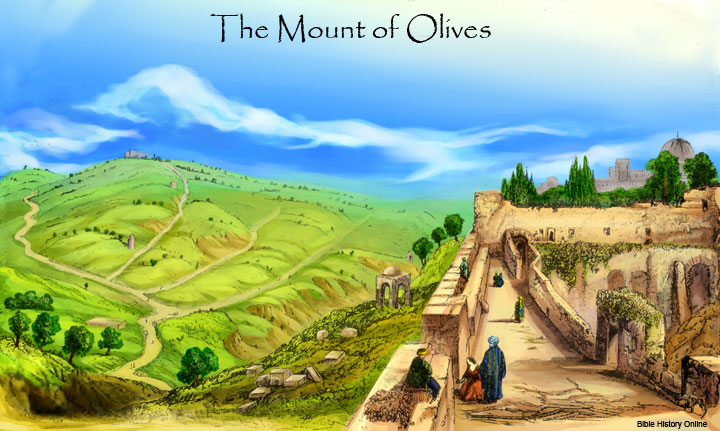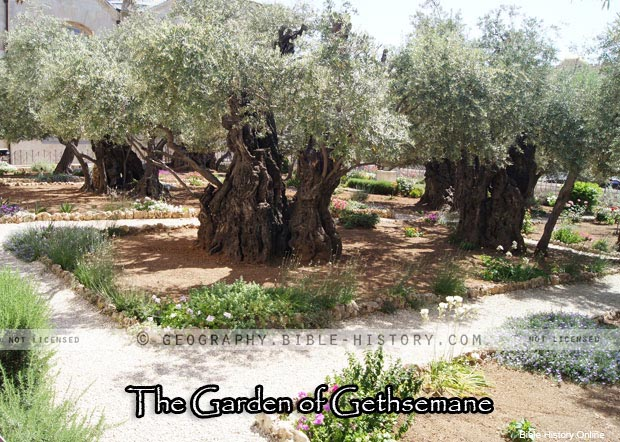The Mount of Olives - First Century Jerusalem

Painting of the Mount of Olives as it looked in the Nineteenth Century
The Mount of Olives was a ridge of hills east of Jerusalem, separated from it by the Kidron or Jehoshaphat Valley. The Mount of Olives where Jesus prayed was outside the city, opposite the eastern wall of the Temple . Here was the garden of Gethsemane which means "olive press."
A north-to-south ridge of hills east of Jerusalem where Jesus was betrayed on the night before His crucifixion. This prominent feature of Jerusalem's landscape is a gently rounded hill, rising to about the height of 830 meters (2,676 feet) and overlooking the Temple.
The closeness of the Mount of Olives to Jerusalem's walls made this series of hills a grave strategic danger. The Roman commander Titus had his headquarters on the northern extension of the ridge during the siege of Jerusalem in 70 AD. He named the place Mount Scopus, or "Lookout Hill," because of the view which it offered over the city walls. The whole hill must have provided a platform for the Roman catapults that hurled heavy objects over the Jewish fortifications of the City.
In ancient times the whole mount must have been heavily wooded. As its name implies, it was covered with dense olive groves.
The Mount of Olives is also mentioned in a reference by the prophet Zechariah to the future Day of the Lord: "In that day His feet will stand on the Mount of Olives, which faces Jerusalem on the east. And the Mount of Olives shall be split in two from east to west, making a very large valley; half of the mountain shall move toward the north and half of it toward the south" (Zech 14:4).
In the New Testament the Mount of Olives played a prominent part in the last week of our Lord's ministry. Jesus approached Jerusalem from the east, by way of Bethphage and Bethany, at the Mount of Olives (Mt 21:1; Mk 11:1). On the night of His betrayal, He and His disciples sang a hymn and went out to the Mount of Olives (Mt 26:30; Mk 14:26), to the Garden of Gethsemane (Mt 26:36; Mk 14:32). In this garden, on the slopes of the Mount of Olives, Jesus was betrayed by Judas and delivered into the hands of His enemies.
Name. Its descriptive appellation is "the Mount of Olives" (Heb. har hazzetim, only in Zech 14:4; Grk. to oros tou elaiov, the mount on which the olive grew; Matt 21:1; 24:3; 26:30; Mark 11:1; Luke 19:37; John 8:1). It is referred to (2 Sam 15:30) as "the ascent of the Mount of Olives"; "the mountain which is east of Jerusalem" (1 Kings 11:7); "the mount of destruction" (2 Kings 23:13), from the heathen altars erected there by Solomon (cf. 1 Kings 11:7); "the hills" (Neh 8:15), and "the mount called Olivet" (Acts 1:12). The hill has now two names, Jebel et-Tur, i.e., "the Mount," and Jebel et-Zeitun, "Mount of Olives."
Physical Features. The Mount of Olives is a limestone ridge, rather more than a mile in length, running in general direction N and S and covering the whole eastern side of the city of Jerusalem. At the N the ridge bends to the W, enclosing the city on that side also. At the N about a mile intervenes between the city walls, while on the E the mount is separated only by the valley of Kidron. It is to the latter part that attention is called. At a distance its outline is almost horizontal, gradually sloping away at its southern end; but when seen from below the eastern wall of Jerusalem, it divides itself into three or perhaps four independent summits or natural elevations. Beginning at the N they are: Galilee or Viri Galilaei, from the address of the angel to the disciples (Acts 1:11); Mount of Ascension, now distinguished by the minaret and domes of the Church of the Ascension, in every way the most important; Mount of the Prophets, subordinate to the former; and Mount of Offense. Three paths lead from the valley to the summit. The first passes under the N wall of the enclosure of Gethsemane and follows the line of the depression between the center and the northern hill. The second parts from the first about fifty yards beyond Gethsemane and, striking off to the right up the very breast of the hill, surmounts the projection on which is the traditional spot of the lamentation over Jerusalem and thence proceeds directly upward to the village of Bethany. The third leaves the other two at the NE corner of Gethsemane and, making a considerable detour to the S, visits the so-called "Tombs of the Prophets" and, following a slight depression that occurs at that part of the mount, arrives in its turn at Bethany. Every consideration is in favor of the first path being that which David took when fleeing from Absalom, as well as that usually taken by our Lord and His disciples in their morning and evening walks between Jerusalem and Bethany, and that also by which the apostles returned to Jerusalem after the ascension. Tradition assigns many sacred sites to the Mount of Ascension, Gethsemane, and the place of lamentation. The third of the traditional spots mentioned-that of the lamentation over Jerusalem (Luke 9:41-44)-has been shown to have been badly chosen and that the road of our Lord's "triumphal entry" was not by the short and steep path over the summit but the longer and easier route around the southern shoulder of the southern of the three divisions of the mount.
Scripture Notices. The Mount of Olives is mentioned in connection with the flight of David from Absalom (2 Sam 15:30); with the building there of high places by Solomon (2 Kings 23:13); and with the vision of the Lord's departure from Jerusalem (Ezek 10:4,19; 11:23), in which last passage the prophet said, "And the glory of the Lord went up from the midst of the city, and stood over the mountain which is east of the city." The command to "go out to the hills, and bring olive branches," etc. (Neh 8:15), indicates that the mount, and probably the valley at its base, abounded in various kinds of trees. In the time of Jesus the trees were still numerous (Mark 11:8). The only other OT mention of the Mount of Olives is in Zechariah's prophecy of the destruction of Jerusalem and the preservation of God's people (Zech 14:4). The NT narrative makes Olivet the scene of four remarkable events in the history of Jesus: the triumphal entry-its scene being the road that winds around the southern shoulder of the hill from Bethany to Jerusalem (Matt 21:1,8-10; Mark 11:1,8-10; Luke 19:29,36-37,41); the prediction of Jerusalem's overthrow (Mark 13:1-2); Gethsemane-after the institution of the Lord's Supper, Jesus led His disciples "over the ravine of the Kidron" and "out to the Mount of Olives," to a garden called Gethsemane (John 18:1; Matt 26:30,36)

Photo of the Traditional Site of the garden of Gethsemane on the Mount of Olives
Also See:
Herod's Temple
![]()
Read The Bible
- 1599 Geneva Bible (GNV)
- 21st Century King James Version (KJ21)
- American Standard Version (ASV)
- Amplified Bible (AMP)
- Amplified Bible, Classic Edition (AMPC)
- Authorized (King James) Version (AKJV)
- BRG Bible (BRG)
- Christian Standard Bible (CSB)
- Common English Bible (CEB)
- Complete Jewish Bible (CJB)
- Contemporary English Version (CEV)
- Darby Translation (DARBY)
- Disciples’ Literal New Testament (DLNT)
- Douay-Rheims 1899 American Edition (DRA)
- Easy-to-Read Version (ERV)
- English Standard Version (ESV)
- English Standard Version Anglicised (ESVUK)
- Evangelical Heritage Version (EHV)
- Expanded Bible (EXB)
- GOD’S WORD Translation (GW)
- Good News Translation (GNT)
- Holman Christian Standard Bible (HCSB)
- International Children’s Bible (ICB)
- International Standard Version (ISV)
- J.B. Phillips New Testament (PHILLIPS)
- Jubilee Bible 2000 (JUB)
- King James Version (KJV)
- Lexham English Bible (LEB)
- Living Bible (TLB)
- Modern English Version (MEV)
- Mounce Reverse Interlinear New Testament (MOUNCE)
- Names of God Bible (NOG)
- New American Bible (Revised Edition) (NABRE)
- New American Standard Bible (NASB)
- New American Standard Bible 1995 (NASB1995)
- New Catholic Bible (NCB)
- New Century Version (NCV)
- New English Translation (NET)
- New International Reader's Version (NIRV)
- New International Version - UK (NIVUK)
- New International Version (NIV)
- New King James Version (NKJV)
- New Life Version (NLV)
- New Living Translation (NLT)
- New Matthew Bible (NMB)
- New Revised Standard Version (NRSV)
- New Revised Standard Version Catholic Edition (NRSVCE)
- New Revised Standard Version, Anglicised (NRSVA)
- New Revised Standard Version, Anglicised Catholic Edition (NRSVACE)
- New Testament for Everyone (NTE)
- Orthodox Jewish Bible (OJB)
- Revised Geneva Translation (RGT)
- Revised Standard Version (RSV)
- Revised Standard Version Catholic Edition (RSVCE)
- The Message (MSG)
- The Voice (VOICE)
- Tree of Life Version (TLV)
- World English Bible (WEB)
- Worldwide English (New Testament) (WE)
- Wycliffe Bible (WYC)
- Young's Literal Translation (YLT)
Table of Contents
Main Menu
- Ancient Assyrian Social Structure
- Ancient Babylonia
- Ancient Canaan During the Time of Joshua
- Ancient History Timeline
- Ancient Oil Lamps
- Antonia Fortress
- Archaeology of Ancient Assyria
- Assyria and Bible Prophecy
- Augustus Caesar
- Background Bible Study
- Bible
- Biblical Geography
- Fallen Empires - Archaeological Discoveries and the Bible
- First Century Jerusalem
- Glossary of Latin Words
- Herod Agrippa I
- Herod Antipas
- Herod the Great
- Herod's Temple
- High Priest's in New Testament Times
- Jewish Literature in New Testament Times
- Library collection
- Map of David's Kingdom
- Map of the Divided Kingdom - Israel and Judah
- Map of the Ministry of Jesus
- Matthew Henry Bible Commentary
- Messianic Prophecy
- Nero Caesar Emperor
- Online Bible Maps
- Paul's First Missionary Journey
- Paul's Second Missionary Journey
- Paul's Third Missionary Journey
- Pontius Pilate
- Questions About the Ancient World
- Tabernacle of Ancient Israel
- Tax Collectors in New Testament Times
- The Babylonian Captivity
- The Black Obelisk of Shalmaneser
- The Books of the New Testament
- The Court of the Gentiles
- The Court of the Women in the Temple
- The Destruction of Israel
- The Fall of Judah with Map
- The History Of Rome
- The Incredible Bible
- The Jewish Calendar in Ancient Hebrew History
- The Life of Jesus in Chronological Order
- The Life of Jesus in Harmony
- The Names of God
- The New Testament
- The Old Testament
- The Passion of the Christ
- The Pharisees
- The Sacred Year of Israel in New Testament Times
- The Samaritans
- The Scribes
Ancient Questions
- Why Do the Huldah Gates Appear Different in Ancient Replicas and Modern Photos?
- What Is the Origin of the Japanese and Chinese Peoples? A Biblical Perspective
- How did the ancient Greeks and Romans practice medicine and treat illnesses?
- What were the major contributions of ancient Babylon to mathematics and astronomy?
- How did the ancient Persians create and administer their vast empire?
- What were the cultural and artistic achievements of ancient India, particularly during the Gupta Empire?
- How did ancient civilizations like the Incas and Aztecs build their remarkable cities and structures?
- What were the major trade routes and trading practices of the ancient world?
- What was the role of slavery in ancient societies like Rome and Greece?
- How did the ancient Mayans develop their sophisticated calendar system?
Bible Study Questions
- Why Do Christians Celebrate Christmas?
- How Many Chapters Are There in the Bible?
- The Five Key Visions in the New Testament
- The 400-Year Prophecy: Unpacking Genesis 15 and the Journey of a People
- The Authorized (King James) Version (AKJV): Historical Significance, Translation Methodology, and Lasting Impact
- Exploring the English Standard Version (ESV): Its Aspects, Comparisons, Impact on Biblical Studies, and Church Use
- A Detailed Historical Analysis of Language Updates in the KJ21: Comparison with Other Versions
- A Detailed Historical Analysis of the American Standard Version (ASV): Comparison to the King James Version, Influence on Later Translations, and Evaluation of Strengths and Weaknesses
- A Detailed Historical Analysis of Amplifications in the Amplified Bible (AMP) and Its Comparison to Other Bible Translations
- Detailed Historical Analysis of the Amplified Bible Classic Edition (AMPC): Examples of Amplifications and Comparative Analysis with Other Bible Translations
About
Welcome to Free Bible: Unearthing the Past, Illuminating the Present! Step into a world where ancient history and biblical narratives intertwine, inviting you to explore the rich tapestry of human civilization.
Discover the captivating stories of forgotten empires, delve into the customs and cultures of our ancestors, and witness the remarkable findings unearthed by dedicated archaeologists.
Immerse yourself in a treasure trove of knowledge, where the past comes alive and illuminates our understanding of the present.
Join us on this extraordinary journey through time, where curiosity is rewarded and ancient mysteries await your exploration.
Recent posts
-

Best gemstones for stud earrings for 15 years girl
Selecting the perfect pair of stud earrings for a 15-year-old girl is an exciting yet thoughtful process. Stud earrings are a timeless accessory, offe... -

Prayers for Prophets: A Reflection on Reverence and Intercession
Prophets hold a revered status across many of the world’s major religions. As individuals chosen to convey divine messages, they are often remembere... -

How Machine Learning is Reducing Risk in Automated Trading
In today’s fast-paced monetary markets, automated buying and selling has come to be a cornerstone of current making an investment. Algorithms now ex... -

Timur Turlov: Driving Global Investment Innovation Through Freedom Holding Corp.
Timur Turlov leads Freedom Holding Corp. (NASDAQ: FRHC) as its CEO where he connects technology with finance and global markets. Turlov established Fr... -

AI in the Legal Industry: Can Algorithms Replace Lawyers?
The legal career is historically considered as a discipline rooted in human judgment, nuance, and vital questioning. But in recent years, Artificial I...